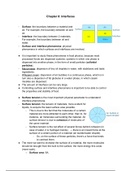Chapter 8: Interfaces
- Surface: the boundary between a material and
air. For example, the boundary between oil and
air.
- Interface: the boundary between 2 materials.
For example, the boundary between oil and
water.
- Surface and interface phenomena: physical
phenomena in which surfaces and interfaces are involved.
● It is important to study these phenomena in food physics, because most
processed foods are dispersed systems: systems in which one phase is
dispersed into another phase, in the form of small particles (colloidal
particles).
- Mayonnaise: dispersion of tiny oil droplets in water, with stabilizers and taste
ingredients.
- Whipped cream: dispersion of air bubbles in a continuous phase, which is in
turn also a dispersion of fat globules in a water phase, in which casein
micelles are dispersed.
● The amount of interface can be very large.
● Controlling surface and interface phenomena is important to be able to control
the properties and stability of food.
● Surface tension is the most important physical parameter to understand
interface phenomena.
- Surface tension: the tension of materials, more evident for
liquids, to acquire the least surface area possible.
- This is due to the fact that the molecules of a certain
material are more attracted to each other, than to, for
instance, air molecules surrounding the material. So
surface tension is due to cohesion of molecules of
the same material.
- Surface tension is the net effect of several forces behind cohesion (in
case of water, it is hydrogen bonds). → there is an inward force at the
surface of a certain portion of a material (air bubble/water droplet).
- So, on the surface of these particles, there’s a force that tends
to contract them.
● The more we want to increase the surface of a material, the more molecules
should be brought from the bulk to the surface, the more energy this costs
(more work).
○ Surface area: δA.
, ○ Amount of work: δW.
○ Surface tension: γ (N/m): the proportionality constant between the
applied energy and the new surface, created by this applied energy.
■ The unit of surface tension is thus N/m. So, if you know the
weight of the paper clip (soap film example) in N, and you divide
it by the length of the film, then you know what the surface
tension is.
○ δW = γ * δA.
- Wilhelmy-plate method: measurement of
surface tension.
- You have to consider a plate with a
certain length, certain width and a
certain weight, that is kept vertical
in a liquid of which we want to know
the surface tension.
- By measuring the force needed to
keep the plate vertical in the liquid,
you can determine the surface
tension of the liquid. F = m*g + 2(W
+ t) * γ.
- Du Nouy-ring method: measurement of surface
tension.
- A ring with a certain weight and a certain
inner and outer circumference, is kept
immersed in a liquid of which we want to
measure the surface tension.
- The weight of the ring, and the surface
tension acting on both perimeters of the
ring (internal and external ones), will tend
to pull the ring down.
- Measuring the force needed to pull the ring out of the liquid, allows to
calculate the surface tension of the liquid: F = m*g + 2πγ (Ri +
Ro).
● Water has the highest surface tension, from all liquids found in nature (with
mercury as only exception), because of the many hydrogen bonds present.
● By increasing the temperature, the surface tension of a liquid decreases,
because with increasing temperature the thermal motions of the molecules
also increase. It is therefore easier to bring a molecule from the bulk to the
surface.
● The surface tension is generally related to the density of the material: the
lower the density, the lower the surface tension.
● The presence of proteins in water decreases the surface tension. Other
molecules can have this effect too, they’re called surfactants.




